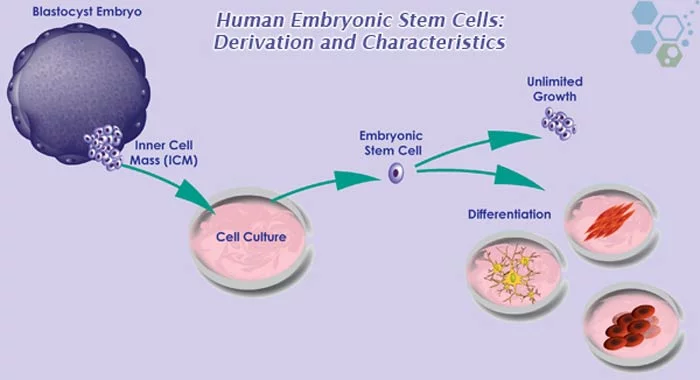
Human embryonic stem cell line or hESC are also referred to as simply Embryonic stem cells. ES cells pertains to a pluripotent lineage of cells that are typically derived from a human embryo (after zygote) at its earliest stage.
Embryonic cells of the morular are totipotent. ES cells are considered very powerful in regenerative medicine since they can undergo cell division even without differentiation, which could go for extended periods,[3] and eventually develop into the cells composing the three germ layers.
All 3 of the previous ES cells typically require isolation from fetal or embryonic tissue. Some ES lines such as induced pluripotent cells however can now be can be cultured in our labs using special growth medium but are still very difficult to control during mesoderm production and the differentiation process.[2]
The Regeneration center of Thailand does not use Embryonic stemcell lines in any of its treatments. Our cell therapies use allogeneic or autologous Adult stem cells only.
[1] ^ Yang, Heung-Mo, Sung-Hwan Moon, Young-Sil Choi, Soon-Jung Park, Yong-Soo Lee, Hyun-Joo Lee, Sung-Joo Kim, and Hyung-Min Chung. 2013. Therapeutic efficacy of human embryonic stem cell-derived endothelial cells in humanized mouse models harboring a human immune system. Arteriosclerosis, thrombosis, and vascular biology, no. 12 (October 3). doi:10.1161/ATVBAHA.113.302462. https://www.ncbi.nlm.nih.gov/pubmed/24092748
[2] ^ Soteriou, Despina, Banu Iskender, Adam Byron, Jonathan D Humphries, Simon Borg-Bartolo, Marie-Claire Haddock, Melissa A Baxter, David Knight, Martin J Humphries, and Susan J Kimber. 2013. Comparative proteomic analysis of supportive and unsupportive extracellular matrix substrates for human embryonic stem cell maintenance. The Journal of biological chemistry, no. 26 (May 8). doi:10.1074/jbc.M113.463372. https://www.ncbi.nlm.nih.gov/pubmed/23658023
[3] ^ Hung, Sandy S C, Raymond C B Wong, Alexei A Sharov, Yuhki Nakatake, Hong Yu, and Minoru S H Ko. 2013. Repression of global protein synthesis by Eif1a-like genes that are expressed specifically in the two-cell embryos and the transient Zscan4-positive state of embryonic stem cells. DNA research : an international journal for rapid publication of reports on genes and genomes, no. 4 (May 5). doi:10.1093/dnares/dst018. https://www.ncbi.nlm.nih.gov/pubmed/23649898
If you've seen people take ice baths or cold showers and wondered if they're onto… Read More
Immunomodulation stands at the forefront of biomedical research, steering the immune system's ability to fight… Read More
Stem cell research leads the charge in medical innovation, heralding revolutionary advances in regenerative medicine.… Read More
The blood-brain barrier (BBB) is a crucial shield for the brain, regulating the entry of… Read More
While peptide bonds are fundamental to protein structure, their direct relationship with stem cells lies… Read More
When discussing cutting-edge cancer treatments, NK cell therapy stands out due to its unique approach… Read More